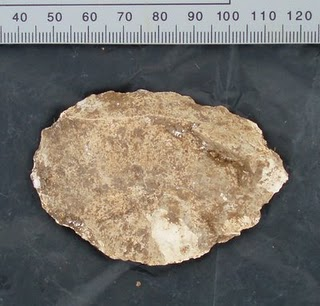Tales of the Bustard Saturday, June 7th, 2008
|
|
|
|
|
Apologies, dear reader, for leaving you hanging with the tales of the Bustard – our heroes in the rain with only a cake to sustain… Unfortunately the rain meant that we had to work twice as hard on the remaining 3 days to achieve our ends, so blogging rather suffered.
_
So, I hear you cry, what DID happen?
_
We opened several areas, some of which were blank and one of which had the most marvellous section of trench in it. The picture is here:
_

Image Copyright:Defence Estates
_
Scale is 1m vertical and 2m horizontal. The stain running along the base of the trench is believed to be the marks left by a rotted trench board.
_
Oddly there were no 1914-18 finds, by contrast to the 2006 dig when we found lots of materiel. This suggests that the soldiers were made to clear up after their exercise.
_
One find that did turn up was a Prehistoric flint in the backfill of another communication trench. It just goes to show that the archaeological landscape is indeed a palimpsest, layered and full of artefacts stories and meanings.
_

Copyright: Defence Estates
_
Happily the Bristol students were still smiling when they left us (maybe with relief at leaving) and all agreed that it had been an interesting and useful week.
_
We would have preferred to have found more evidence of the use of the trenches but the excavated section does show that the soldiers were digging proper features to the prescribed death to afford head cover and to keep you relatively safe in the battlefield in Flanders or France. Good training? It looks like it!
|
|
|
|
|
|
Filed under: A Dig Diary by
admin
Add a Comment »
|
|
Rain Tuesday, June 3rd, 2008
|
|
|
|
|
It was raining all night and it is still raining now.
_
At 8 we decided to stay off site for the morning and see what the weather did…at 12.30 “rain stopped play” and the day was binned.
_
Tomorrow everyone will work harder to make up for lost time ;-)
_
There will be a cake though, as your correspondent had occasion to go the the excellent bakery on the A303 near Yeovilton.
_
More news as it happens!
|
|
|
|
|
|
Filed under: A Dig Diary by
admin
Add a Comment »
|
|
Back to the Bustard Monday, June 2nd, 2008
|
|
|
|
|
Monday 2nd June and we were joined on Salisbury Plain by a team of Bristol University students, ably led by Nick Saunders. They have joined us to spend a week digging on the site of the Anzac 3rd Division training trenches at The Bustard on Salisbury Plain. The site takes it’s name from the large bird and from the nearby pub named after it.
_
In 1916 the Australian soldiers took over, adapted and trained in a series of trenches dug on Salisbury Plain to instruct and inform soldiers in the practice of trench digging, maintenance, routine and life. The Australians are known to have spent days and nights in the trenches familiarising themselves with trench life. They are known to have been involved in exercises with live fire and the blowing of a small mine, which they seem then to have “captured” and fortified, just as they were to do at Ultimo crater, during the Battle of Messines.
_
The dig is designed to do a number of things. It will see what can be discerned in the archaeological record of the activities of these and other soldiers. The dig will also assess the survival and condition of the remains. Information gained here will add to the picture of preparation for War in 1916/17.
_
Richard and Martin led an NML team here in 2005 but since then there has been neither opportunity nor resources to return so the help given by Bristol is invaluable.
|
|
|
|
|
|
Filed under: A Dig Diary by
admin
Add a Comment »
|
|